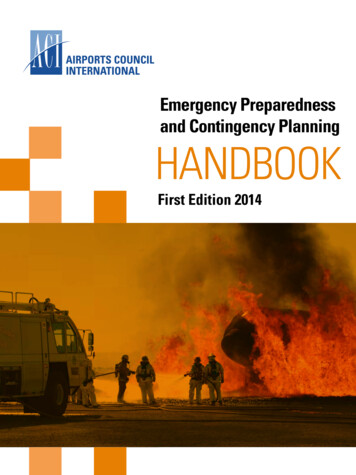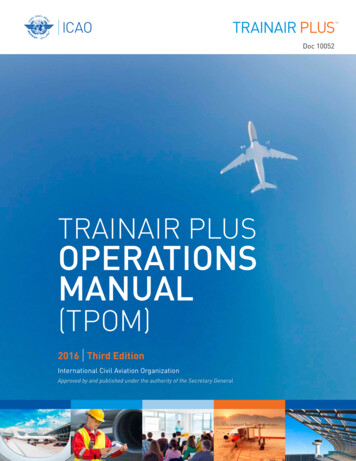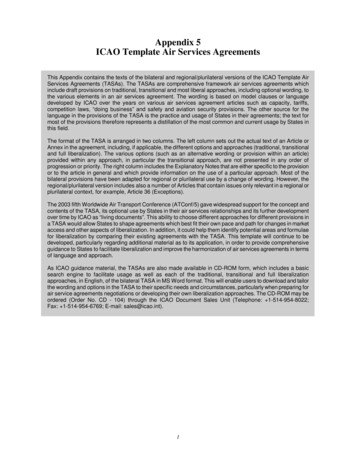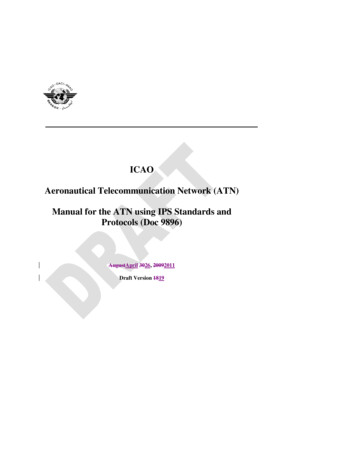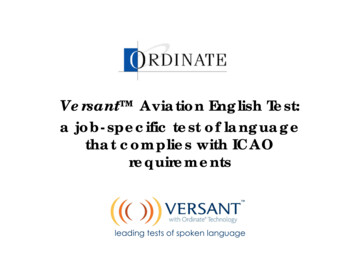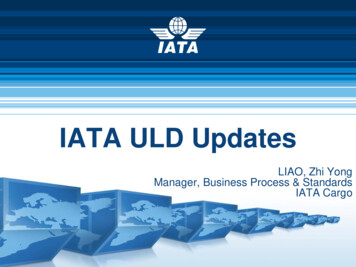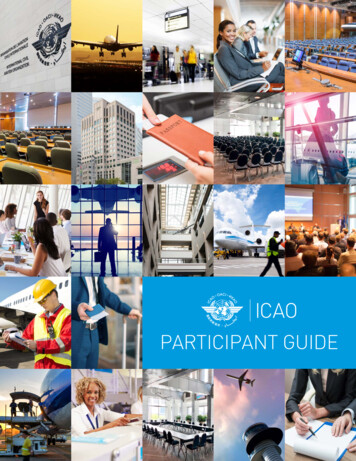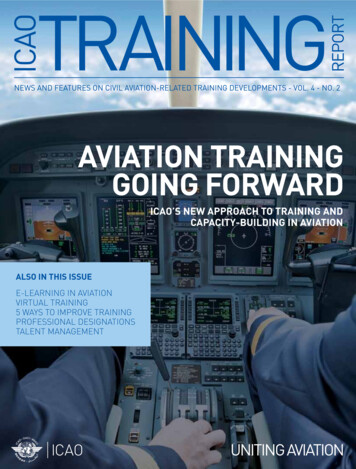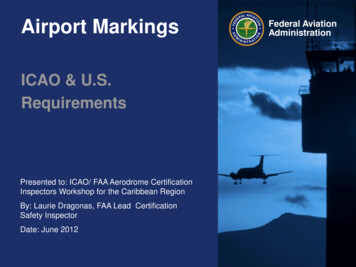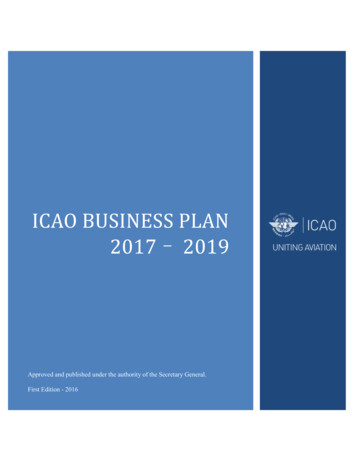
Transcription
ICAO BUSINESS PLAN2017– 2019Approved and published under the authority of the Secretary General.First Edition - 2016
Message from the Secretary GeneralAs we prepare for the approaching 2017 – 2019 triennium, I believe we have the unique opportunity tochart a course for ICAO, ensuring it flourishes in the future as the global forum for international civilaviation and strengthens its leadership role within the global aviation sector.In 2015, 100 000 daily flights were managed safely and a total number of 3.5 billion passengers werecarried, by some 1 400 commercial airlines, connecting 4 130 airports through airspace managed by 173air navigation services providers. Aviation currently moves over half of the 1.1 billion tourists who travelacross international borders each year – a figure which rises to over 80 per cent in various small islandStates. It also transports some 35 per cent of world trade by value and contributes to the creation of 8.5million jobs and to around 700 billion dollars to global gross domestic product (GDP). Because of itscross-cutting nature and multiple links to other economic sectors, the total economic impact of aviationreaches some 3.5 per cent of world GDP, equivalent to 2.4 trillion dollars, with the creation of 58.1million jobs.More importantly, aviation can continue to help to create and preserve friendship and understandingamong the nations and people of the world and transform lives and societies by connecting the world. Itallows access to new technologies, business opportunities and opens global markets for rural producers.For Landlocked Developing Countries (LLDCs) and Small Island Developing States (SIDS) especially,aviation represents an essential lifeline to enhance connectivity, which in turn promotes greater tourism,trade and other vital business activities. Aircraft are also well-appreciated for their role in carryinglifesaving medicines to communities in need, urgent supplies for disaster relief, and in reducing povertythrough all of the economic factors I have already outlined.Going forward, ICAO has been proactively working with the international community to address thechallenges of rapidly-expanding air traffic, which is now projected to double by 2030. To foster thisprojected growth in a sustainable manner and produce inclusive and productive development andemployment, aviation must have coherent policies with tourism, trade and other transport sectors tofurther improve connectivity and modernize infrastructure. These measures alone could nearly doubleaviation’s share of GDP to 5.8 trillion dollars in the next 15 years. Upgrading air traffic systems, forexample, would contribute to the global economy an estimated 300 billion dollars per year.ICAO has launched a No Country Left Behind initiative to assist States to effectively implementICAO Standards and Recommended Practices (SARPs) and policies, leading to the improvementof their air connectivity and access to the global aviation system. An increase in connectivityspurs tourism and trade, creates jobs, and generates numerous economic benefits supportingpoverty eradication. This growth subsequently feeds into aviation re-investment creating asustainable and healthy cycle of national aviation and economic development. With the recentadoption of the 2030 Agenda for Sustainable Development, for the first time air transport is nowconsidered an enabler of sustainable development; and as such improvements in this sector should beinherently linked to and embedded within, global, regional and national development frameworks. ICAOis actively engaged, in concert with its Strategic Objectives, in supporting the implementation of the 2030Agenda by assisting its Member States in enhancing their air transport systems with a view of ultimatelycontributing, to the United Nations (UN) Sustainable Development Goals (SDGs).Bearing this in mind, I am convinced that we can chart a course to ensure ICAO is ready and relevant tomeet the needs of global civil aviation. Ultimately, I would like for us to lay out a strategic direction forICAO, ensuring that it is optimally organized and staffed both operationally and administratively,efficiently run, financially sound and viable, and beholden to realistic performance and resultsmanagement measures. Developing this strategic direction may result in a fundamental change as to howwe approach our work and may thus require a “Corporate or Organizational Change” to meet these goals.
-2The tangible next step in this process is the ICAO Business Plan 2017 – 2019, which is a living document,and a joint endeavour between the Council and the Secretariat. The ICAO Business Plan 2017 – 2019 isthe foundation for the planning of activities and resource allocation as reflected in the ICAO OperatingPlan and results-based Regular Programme Budget for the 2017 – 2019 triennium.Dr. Fang Liu
-3-INTENTIONALLY LEFT BLANK
Table of ContentsExecutive SummaryiIntroduction1The Global Aviation Context1The Role of States3The Role of ICAO3The ICAO Strategic Objectives4No Country Left Behind5ICAO and United Nations 2030 Agenda for Sustainable Development5Building on Achievements8Emerging Aviation Issues9Existing and Emerging Challenges10Internal Risk Factors Influencing ICAO’s Work10External Risk Factors Influencing ICAO’s Work10ICAO Priorities 2017 – 201911Key Priorities11Focus Areas12Expected Results14ICAO Funding Mechanisms & Resource Mobilization17Regular Programme Budget17Ancillary Revenue Generation Fund (ARGF)17Administrative and Operational Services Cost (AOSC) Fund17Voluntary Funds18In-Kind Contributions19Other Funds19Resource Mobilization19Efficiency Gains19Operational Efficiency20Operational Cost Reductions 22
-2Annex I – The Relationship between the Regular Programme Budgetand the Business PlanA1Annex II – Schematic Representation of Relationship between Strategic Objectives,Key Priorities and Expected ResultsA2Annex III – ICAO Operating Plan 2017 – 2019A3Annex IV – Corporate Key Performance Indicators (TBD)A4Annex V – Risks (TBD)A5Annex VI – Glossary of TermsA6————————
Executive SummaryThe Global Aviation ContextAviation is the great connector of people and the world, overcoming oceans and borders, creatingeconomic growth, and contributing to sustainable development. A strong and affordable global airtransport network helps improve quality of life, spread knowledge of different societies and cultures,deliver better services and aid to the public, and enhance access to remote and lesser-developed areas.With 3.5 billion passengers, 50 million tons of freight, some 1 400 commercial airlines, 26 700 aircraft inservice, 4 130 airports, 173 air navigation services providers, and 100 000 daily flights around the world,aviation is a global industry affecting all sectors of the economy.Aviation directly contributed to the creation of 8.5 million jobs and approximately USD 700 billion to theglobal gross domestic product (GDP). Because of its cross-cutting nature and multiple links to othereconomic sectors, the total economic impact of aviation reaches some 3.5 per cent of world GDP,equivalent to USD 2.4 trillion, with the creation of over 58 million jobs.The continued growth of a safe, secure, efficient, economically viable and environmentally responsible airtransport network is direct benefit to the world’s economy.The Role of StatesState governments set national priorities and allocate resources to attain various development objectivesand to meet people’s expectation according to such priorities. As the statutory authority in each State,Civil Aviation Authorities (CAAs) and other agencies oversee various aspects of civil aviation in theirrespective countries and are responsible for implementing and achieving the priorities and expectationsset by the State governments.The Role of ICAOThe International Civil Aviation Organization (ICAO) is a specialized agency of the United Nations(UN), established by States in 1944 to manage the administration and governance of international civilaviation as mandated by the Convention on International Civil Aviation (Chicago Convention). ICAO’smission is “to serve as the global forum of States for international civil aviation. ICAO develops policiesand Standards, undertakes compliance audits, performs studies and analyses, provides assistance andbuilds aviation capacity through many other activities and the cooperation of its Member States andstakeholders.”ICAO works with its 191 Member States, as well as industry stakeholders, to reach consensus oninternational civil aviation Standards and Recommended Practices (SARPs) and policies in support of asafe, secure, efficient, economically sustainable and environmentally responsible civil aviation sector.Member States implement these SARPs and policies within their local civil aviation regulations to ensurethat their local civil aviation operations conform to global norms, which in turn permits more than100 000 daily flights in aviation’s global network to operate safely and reliably in every region of theworld.
iiThe ICAO Business PlanThe ICAO Business Plan sets the Strategic Objectives, and priorities to guide the activities of theOrganization to enable Members States to attain a safe, secure, efficient, economically viable andenvironmentally responsible air transport network. The Plan emphasizes ten (10) Key Priorities toadvance the realization of the fifteen (15) Expected Results attributable to the Organization’s five (5)Strategic Objectives: Safety, Air Navigation Capacity and Efficiency, Security and Facilitation,Economic Development of Air Transport, and Environmental Protection, which are designed to benefitglobal civil aviation and Member States.The ICAO Business Plan is a living document that must be continuously adjusted to meet the changingneeds of States and the global aviation community. To that end changes to relevant elements of theBusiness Plan including the review of emerging aviation issues, the assessment and mitigation of internaland external risk factors, and the implementation of the work programme through the Operating Plan aremonitored, updated and optimized by the Secretariat on an ongoing basis. The Corporate PerformanceManagement Framework provides clarity and transparency to these adjustments, through which the ICAOBusiness Plan remains inuousSafetyImprovementsAir NavigationCapacity andEfficiencyHarmonizedGlobal AirNavigationModernizationSecurity andFacilitationContinuousAviationSecurity andFacilitationImprovementsEXPECTED RESULTS123456Improved Aviation Safety: Enhanced capabilities ofStates to manage risks, associated with aviationactivities to an acceptable level of safety performance.Strengthened Regulatory Capacity: Enhancedcapabilities of States, in particular those with low levelsof effective implementation of global standards, tofulfil their mandates.Increased Air Navigation Capacity:Enhancedcapabilities of States to access develop, implement anduse technologies in Air Navigation Systems to meetcurrent and future demand.Optimized the performance of the Global AviationSystem: Enhanced the capabilities of States tomaximize the benefits of the use of existing technicalcapabilities and technologies, and increase the return oninvestment of new ones.Reduced Aviation Security Risk: Enhancedcapabilities of States to reduce the level of risk posedby existing, new and emerging threats to civil aviationand boarder integrity by effective regulatory oversightframeworks and implementation of countermeasuresand responses commensurate with the level of threat, aswell as the harmonized global aviation security policyframework.Improved Efficiency in Border ClearanceOperations: Enhanced capabilities of States tofacilitate movement of people and goods by air withminimum operational delays, and high quality securityand law enforcement.
iii7EconomicDevelopment ofAir TransportEnhanced Roleof Aviation ironmentallyFriendlyAviation10All StrategicObjectivesQuality Data,Analysis andForecasting11No Country LeftBehind12Training andCapacityBuilding inAviation13TechnicalAssistance andCooperation14Lower Impediments to Air Transport Operations:Enhanced capabilities of States to improve airconnectivity, create more competitive businessopportunities in the marketplace, increase consumer'sbenefits and choices, and reduce financial burden andcosts in performing regulatory oversight functions.Increased Use of Aviation as a Development Tool:Enhanced capabilities of States to use aviation as aneffective means to achieve economic development, inparticular, increase accessibility to funding for aviationinfrastructure development and investment in airconnectivity.Improved Environmental Performance of Aviation:Enhanced capabilities of States to apply integratedmeasures to address aircraft noise and engine vements, and the use of sustainable aviationalternative fuels and a global market-based measure forinternational aviation as appropriate.Reduced Environmental Impact on Global Climate:Enhanced capabilities of States to voluntarily prepareand implement appropriate measures to reduce theirCO2 emissions from international aviation within theharmonized global regulatory framework in consistentwith the UN system environmental protection policiesand practices.Improved Data, Analysis and Forecasting: Enhancedcapabilities of States to use, analysis and exchangeaviation data for decision-making and operationalimprovement and to measure and, to the extentpossible, predict the various aspects of civil aviationdevelopment.Strengthened Capacity Development: Enhancedcapabilities of States in particular developing and leastdeveloped countries to implement global standards andpolicies and improve air connectivity.Strengthened Aviation Professional Skills: Enhancedcapabilities of States to harmonize their trainingprogrammes through the provision of efficient criteriaand procedures for the development and recognition ofcivil aviation training centres and training coursesaddressing ICAO provisions and programmes.Optimized Capacity and Project Delivery: Enhancedcapabilities of States to develop required capacity andimplement aviation related projects in a cost effectivemanner.
ivStrengthening the Rule of Law: Enhancedcapabilities of States and stakeholders to better comply15 with their legal obligations and to cooperate within acommon legal framework and guidance to build upharmonized relations.Note - In order to deliver the Expected Results above to States and the global aviation system in anoptimized manner, ICAO will implement a Corporate Performance Management Framework tocontinually monitor and enhance its accountability and performance with respect to theimplementation of the direction of the Assembly and Council. To that end, a further nine (9)Expected Results are attributed specifically to improving the Supporting Strategies (as described inparagraph 5.3)Enhancing theInternationalLegalFrameworkThe Key Priorities are designed to guide decisions for the upcoming triennium 2017 – 2019 to ensure thatthe Business Plan brings the greatest benefits to Member States and global civil aviation. These prioritiesas well as Expected Results (Annex II) are partially reflected in the draft ICAO results-based RegularProgramme Budget and completely detailed in the draft ICAO Operating Plan (Annex III) which presentstime-bound programme activities and projects. The draft ICAO Operating Plan forms the basis forresource allocation, and defines the performance matrices against which to assess progress to achieveExpected Results.————————
ICAO BUSINESS PLAN FOR 2017 – 20191.1.1INTRODUCTIONThe Global Aviation Context1.1.1The Preamble to the Convention on International Civil Aviation (Chicago Convention)recognizes that “the future development of international civil aviation can greatly help to create andpreserve friendship and understanding among the nations and people of the world”.1.1.2Aviation connects people and the world, overcoming oceans and borders, creatingeconomic growth, and contributing to sustainable development. Aviation provides freedom to travel,enables access to foreign markets, and allows the exchange of cultural experiences. A strong andaffordable global air transport network helps improve quality of life, spread knowledge of differentsocieties and cultures, deliver better services and aid to the public, and enhance access to remote andlesser-developed areas.1.1.3With 3.5 billion passengers, 50 million tons of freight, some 1 400 commercial airlines,26 700 aircraft in service, 4 130 airports, 173 air navigation services providers, and 100 000 daily flightsaround the world, aviation is a global industry affecting all sectors of the economy.1.1.4Aviation currently moves over half of the 1.1 billion international tourists – a figurewhich rises to over 80 per cent in various Small Island Developing States (SIDS). It also transports some35 per cent of world trade by value. In 2014, airlines, the world over, flew almost 44 million kilometres, adistance which is equivalent to travelling from Earth to Venus.1.1.5Moreover, aviation directly contributed to the creation of 8.5 million jobs and to aroundUSD 700 billion to global gross domestic product (GDP). Because of its cross-cutting nature and multiplelinks to other economic sectors, the total economic impact of aviation reaches some 3.5 per cent of worldGDP, equivalent to USD 2.4 trillion, with the creation of over 58 million jobs.Aviation’s Global Employment and GDP Impact
-21.1.6Aviation transforms lives and societies by connecting the people and the world, allowingaccess to new technologies, business opportunities and opening global markets for rural producers.Aviation is also well-appreciated for its role in carrying lifesaving medicines to communities in need,urgent supplies for disaster relief, and in reducing poverty.1.1.7For Landlocked Developing Countries (LLDCs) and SIDS especially, aviation representsan essential lifeline to enhance connectivity, which in turn promotes greater tourism, trade and other vitalbusiness activities. An example of the impact of aviation can be seen by the economic damage caused bythe disruption of air connectivity after the 25 April 2015 earthquake in Nepal has been estimated at USD1 million per day. It is estimated that a one day shutdown of air transport worldwide would costapproximately USD 660 million.1.1.8Historically, the air transport industry doubles in size every fifteen years, and currentforecasts indicate that air traffic volume will double by 2030 with a 4.6 per cent annual growth ofpassenger traffic and a 5.3 per cent growth of freight traffic each year to 2030.1.1.9To foster this projected growth in a sustainable manner and produce inclusive andproductive development and employment, aviation must have coherent policies with tourism, trade andother transport sectors to further improve connectivity and modernize infrastructure using emergenttechnologies and procedures while minimizing any possible adverse impacts this growth on theenvironment. Upgrading air traffic systems, for example, would contribute to the global economy anestimated USD 300 billion per year, at the same time it would produce significant environmental benefits.1.1.10Aviation remains the safest, and a highly efficient mode of transport. The growth ofaviation, which includes a doubling of aircraft movements in the near term, puts pressure on the systemand needs to be managed so that the safety performance and the air navigation capacity remains ahead ofthe current and future demand. If this is not achieved there will be increased delays, fuel burn, and anoverall reduction in the safety levels.
-31.1.11The technical challenges to ensure that capacity of the global aviation system is able tomeet current and future demands, while maintaining public confidence that it is safe, secure andenvironmentally responsible requires the international community to invest significantly in the collectiveproactive efforts: from global policies, to international standards, through to their effectiveimplementation. Virtually every factor of the business of aviation is growing: there will be more airlines,airports, types of aircraft, routes, business models, lessees. This results in the complexity of the systemincreasing exponentially in relation to the growth of traffic and puts tremendous pressure on theregulatory resources and human capacity which are not able to keep pace without the development ofsmarter regulation.1.1.12Continuous improvement in global aviation safety and security is fundamental toensuring air transport continues to play a major role in driving sustainable economic and socialdevelopment around the world. A safe, secure, economically viable and environmentally friendly airtransport system is the ultimate goal of ICAO and its Member States.1.2The Role of States1.2.1State governments set national priorities and allocate resources to attain variousdevelopment objectives and to meet people’s expectation according to such priorities. Civil aviation isoften considered as one of the priority sectors for social and economic development.1.2.2While Transport Ministry/Department is an entity in charge of civil aviation, their day-today regulatory and/or operational functions are, in many States, assigned to the Civil Aviation Authorities(CAAs), which oversee the various aspects of civil aviation, including critical aspects of aircraftairworthiness and their operation. Close coordination and negotiations are required with other States tooperate international air transport services, and with the private sector to ensure the proper funding forsustaining and upgrading the aviation system and for operational improvements.1.2.3Experience gained worldwide indicates that where airports and air navigation services areoperated by autonomous entities their overall financial situation and managerial efficiency have generallyimproved. Such autonomous entities were established by governments, although many, in particularairports, have since been transferred partly or completely to private enterprises. Regardless of theownership and control of airports and air navigation services providers, States are ultimately responsiblefor safety, security and economic oversight of these entities. States’ exercise of their oversightresponsibilities should be clearly separated from the operation and provision of airports and air navigationservices, with roles and powers clearly defined for each function.1.2.4In addition to the CAA, other statutory authorities may be involved in supporting thefunction of the investigation of aircraft accidents and incidents. As for aviation security, Interior andDefence Ministries are responsible entities while economic issues need to be coordinated with Finance,Foreign Affairs and Economic Planning Ministries. In many States, aviation environmental matters arealso left to Environment Ministry.1.3The Role of ICAO1.3.1The International Civil Aviation Organization (ICAO) is a specialized agency of theUnited Nations (UN), established by States in 1944 to manage the administration and governance ofinternational civil aviation as mandated under the Convention on International Civil Aviation (ChicagoConvention). ICAO’s mission is “to serve as the global forum of States for international civil aviation.ICAO develops policies and Standards, undertakes compliance audits, performs studies and analyses,provides assistance and builds aviation capacity through many activities and the cooperation of itsMember States and stakeholders.”
-41.3.2ICAO works with its 191 Member States, as well as industry stakeholders, to reachconsensus on international civil aviation Standards and Recommended Practices (SARPs) and policies insupport of a safe, efficient, secure, economically sustainable and environmentally responsible civilaviation sector. Member States implement these SARPs and policies within their local civil aviationregulations to ensure that their local civil aviation operations conform to global norms, which in turnpermits more than 100 000 daily flights in aviation’s global network to operate safely and reliably inevery region of the world.1.3.3In addition to its core work creating consensus-driven international SARPs and policiesamong its Member States and industry, and among many other priorities and programmes, ICAO alsocoordinates assistance and capacity building for States in support of numerous aviation developmentobjectives; produces global plans to coordinate multilateral strategic progress for safety and airnavigation; monitors and reports on air transport sector performance metrics; and audits States’ civilaviation oversight capabilities in the areas of safety and security.1.3.4Since 1944 the number of Contracting States to the Chicago Convention has increased to191 States. This means that every dollar spent on the development and effective implementation ofstandards and policies recognized as necessary for the safety, security and regularity of internationalaviation, saves multiple dollars in States as it removes the need to invest in multiple agreements. Theinvestment in ICAO therefore provides for cost efficient and scalable solutions to the needs of States andindustry.1.3.5One of the main challenges of ICAO today is the assessment of human resource needsbased on each State’s aviation profile. In this regard, ICAO Regional Offices are at the forefront of theOrganization’s work, more often than not; it is at the regional level where the bulk of ICAO’s work getsaccomplished. Strengthening ICAO’s regional support to address the real needs of the States consistentwith a globally-harmonized framework is imperative for the success of ICAO’s mission and forms anunderlying tenet of the No Country Left Behind (NCLB) initiative as described below.1.4The ICAO Strategic Objectives1.4.1ICAO’s Strategic Objectives (SOs) are directly attributable to the betterment of civilaviation globally and form the foundation for all work undertaken by the Organization. Acknowledgingthe clear need to anticipate and manage the projected doubling of global air transport capacity by 2030without unnecessary adverse impacts on system safety, efficiency, convenience or environmentalperformance, ICAO will continue to work within its five comprehensive Strategic Objectives, which wereestablished in 2014:a) Safety: Enhance global civil aviation safety. This Strategic Objective is focusedprimarily on the State's regulatory oversight capabilities. The Global Aviation SafetyPlan (GASP) outlines the key activities for the triennium;b) Air Navigation Capacity and Efficiency: Increase the capacity and improve theefficiency of the global civil aviation system. Although functionally andorganizationally interdependent with Safety, this Strategic Objective is focusedprimarily on upgrading the air navigation and aerodrome infrastructure anddeveloping new procedures to optimize aviation system performance. The Global AirNavigation Plan (GANP) outlines the key activities for the triennium;c) Security and Facilitation: Enhance global civil aviation security and facilitation.This Strategic Objective reflects the need for ICAO's leadership in aviation security,
-5facilitation and related border security matters. Upon direction from the AssemblyICAO shall develop a Global Aviation Security Plan (GASeP) during this triennium.d) Economic Development of Air Transport: Foster the development of a sound andeconomically-viable civil aviation system. This Strategic Objective reflects the needfor ICAO's leadership in harmonizing the air transport framework focused oneconomic policies and supporting activities; ande) Environmental Protection: Minimize the adverse environmental effects of civilaviation activities. This Strategic Objective fosters ICAO's leadership in all aviationrelated environmental activities and is consistent with the ICAO and UN systemenvironmental protection policies and practices.1.5No Country Left Behind1.6At the behest of the Council, ICAO has launched a No Country Left Behind (NCLB)initiative to assist States to effectively implement ICAO SARPs and policies, leading to improvement oftheir air connectivity and access to the global aviation system. An increase in connectivity spurs tourismand trade, creates jobs, and generates numerous economic benefits supporting poverty eradication. Thisgrowth subsequently feeds into aviation re-investment creating a sustainable and healthy cycle of nationalaviation and economic development.1.6.1Through NCLB, ICAO resolves to be more effective in directly supporting all willingStates that need assistance to develop and improve the aviation system by implementing ICAO’s globalstandards and policies. In its role as an advocate for aviation, ICAO will work with States to ensureaviation be given greater importance in the context of development at the country level. NCLB is a needsbased initiative focusing on those States which require the most assistance and advocates on their behalf.1.6.2NCLB cannot rely solely on ICAO. Its success will hinge on support and collaboration ofresources of partners and donors and requires firm commitment from the States, as well as significantinvestments, involving both aviation and non-aviation sectors. This will allow the well-establishedeconomic development frameworks, both at the international and national levels, to engage in providingresources for the effective implementation of aviation global standards. ICAO must use its unique role asan advocate for aviation by a) promoting and advising governments on the benefits of aviation for theirnational aspirations; b) facilitate the mobilization of resources in cooperation with development banks,funds and other financial instituti
The ICAO Business Plan is a living document that must be continuously adjusted to meet the changing needs of States and the global aviation community. To that end changes to relevant elements of the Business Plan including the review of emerging aviation issues, the assessment and mitigation of internal .
